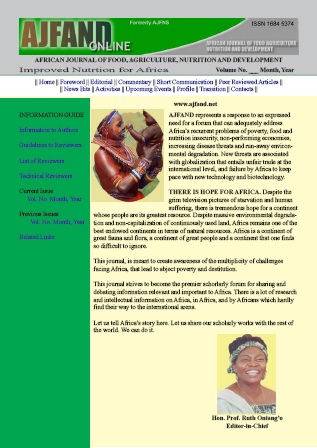
|
African Journal of Food, Agriculture, Nutrition and Development
Rural Outreach Program
ISSN: 1684-5358
EISSN: 1684-5358
Vol. 14, No. 2, 2014, pp. 8709-8724
|
 Bioline Code: nd14020
Bioline Code: nd14020
Full paper language: English
Document type: Research Article
Document available free of charge
|
|
|
African Journal of Food, Agriculture, Nutrition and Development, Vol. 14, No. 2, 2014, pp. 8709-8724
| en |
HOUSEHOLD-FOOD MARKET RELATIONS AND ITS IMPLICATIONS FOR FOOD SECURITY OF FARM FAMILIES IN IMO STATE NIGERIA
Olajide, O.A.
Abstract
The existence of markets is critical to the survival of the farm-household-family system and as such the nature of this relationship and how it affects the dietary supply of the household needs to be understood. The objective of this study is to examine the market relation of farm families by examining the degree of market orientation, the seasonal nature of market sales and purchases and their possible implications for food security. A total of 120 households were selected from the rural areas of Imo state using a multi-stage random sampling technique. The surveyed households were classified into Peri-Urban and Remote Farming Systems (PUFS and RFS) through a hierarchical clustering technique after the data were collected. Descriptive and comparative analyses were carried out using the Mann Whitney Test. The results showed that certain crops (cassava and yams) which command good prices and can yield high income were cultivated on a relatively large scale mainly for processing and consumption by the PUFS. The RFS on the other hand, did not have large outputs but sold about 40 percent of whatever they produced irrespective of its quantity in order to generate cash to meet other household needs. Farm families in the PUFS sold only 19 percent of their total output implying that they produced crops mainly for household consumption. It also showed that households in both systems had to buy food stuff from markets to meet household food supply needs at a period when they were likely to be cash strapped-the hungry season. As such, households compromised the quality of food stuff purchased during such difficult times; this was found to be particularly common in the RFS. At least 40 percent of households in both systems purchased and consumed broken or degraded items from the market during the hungry period. A seasonal intervention is required for short-term remedies while improving storage, processing and transportation facilities will in the long run improve market efficiency and give households better rewards in terms of income and purchased food prices.
Keywords
Household; Market; Food Security; Systems
|
| |
© Copyright 2014 - African Journal of Food, Agriculture, Nutrition and Development
Alternative site location: http://www.ajfand.net/
|
|
